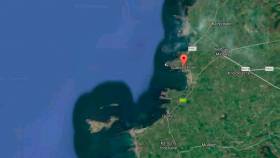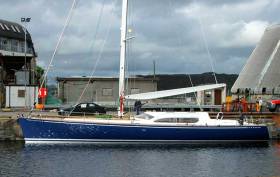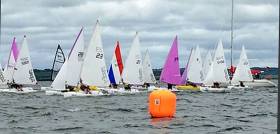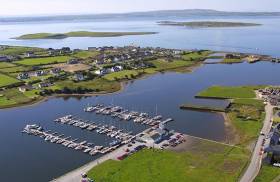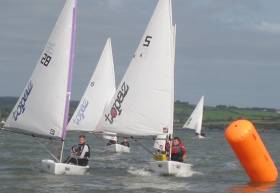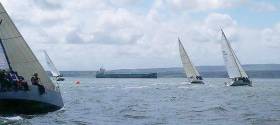Displaying items by tag: Shannon Estuary
A training exercise testing the response capabilities of Shannon Foynes Port Company, local authorities and other organisations who operate in the vicinity of the Shannon Estuary will take place at Spanish Point, County Clare, on Wednesday and Thursday of next week (26-27 April).
The simulated event, which is being hosted by Clare County Council on behalf of the Shannon Estuary Anti-Pollution Team (SEA-PT), will centre on a major spillage of crude oil having occurred from an oil exploration platform located approximately 220km off the south west coast of Ireland and oil coming ashore at Spanish Point.
Other parameters for the exercise will include notification that the source of the pollution has been brought under control and that there have been no casualties on the oil exploration platform.
There will be a practical element on site at Spanish Point involving operation and demonstration of equipment while a technical briefing will be carried out on equipment on site for officials. The second day of the event will consist of the management of a simulated large scale event for senior management of Local Authorities, SEA-PT members and the Coastguard in Clare County Council’s headquarters at Áras Contae an Chláir, Ennis, which will act as the Incident Command Centre.
“Spill simulations are an excellent way to exercise and train personnel in their emergency roles and to test contingency plans and procedures,” explained John Leahy, Senior Engineer, Clare County Council.
“Valuable lessons can be learned from such exercises, which include a variety of participants, such as oil spill management teams, field responders and regulators and community members. Participants will work together in conducting a simulated response to this hypothetical incident in order to demonstrate proficiency and validity of the oil pollution response plan which is in place for Clare,” he said.
Clare County Council has advised that the training event will not be open to the public while the northern end of the public carpark will be closed off to the public on 25th and 26th April. Public access to Spanish Point beach will be maintained throughout the exercise.
Award Winning Foynes Yacht Club Steps Up The Pace
They’re keen on their sailing in Foynes Yacht Club in its sheltered channel behind the island on the south shore of the majestic Shannon Estuary writes W M Nixon. And they’re keen on their teaching too. Elaine O’Mahoney stood down as Honorary Secretary as the club’s honorary secretary at the last AGM after guiding FYC through a period of notable growth. But it seems she stood down not because the job was completed, but because she wished to devote more of her time to teaching people to sail.
 They’re keen on their sailing in Foynes - and the Shannon Estuary has rewarded this FYC Laser with a generous breeze. Photo FYC
They’re keen on their sailing in Foynes - and the Shannon Estuary has rewarded this FYC Laser with a generous breeze. Photo FYC
This makes her a certifiable instructaholic, as her day job in the Autumn, Winter and Spring is as a schoolteacher. But she has the teaching bug big time, she has the sailing bug too, and the result is that Foynes is a national leader with people like Elaine, Simon McGibney, Academy Principal Patrick Finucane, Peadar McGrath and others giving freely and generously of their time to bring more than 200 young people to sailing during 2016.
This Sunday the 19th February, Foynes Yacht Club will open its doors for a Family Day celebration from 2.30pm to 5.30 pm to mark this historic achievement. ISA President David Lovegrove will be in attendance to award each of the instructors and assistant instructors with a memento of the special occasion from the Sailing Academy.
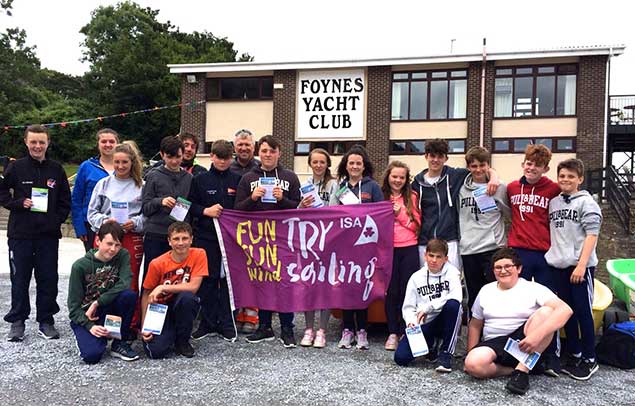 In 2016 Foynes Yacht Club brought more than 200 young people to sailing……Photo FYC
In 2016 Foynes Yacht Club brought more than 200 young people to sailing……Photo FYC
 ….and they covered a wide age range, but all were keen. Photo FYC
….and they covered a wide age range, but all were keen. Photo FYC
In 2015 Foynes Yacht Club was voted Regional Training Centre of the Year and has been delighted to go one better in 2016 with the National Award. It has taken a lot of hard work, dedication, volunteerism and foresight of the club members as a whole.
In recent years the Sailing Academy has upgraded its equipment including wetsuits, buoyancy aids, sails and invested heavily in boats, equipment and facilities. In 2016 Commodore James McCormack facilitated the opening of a new junior shower block consisting of male & female changing rooms and 10 state of the art shower units.
Much of this achievement was made through voluntary effort, and the Commodore’s praise for the club’s key group were echoed by Centre Principal Patrick Finucane, who picked up the award at the recent ceremony in Dublin. When asked what made it happen – he stated ‘Volunteerism and Hard Work’.
A mark of the success of the Sailing Academy is the revival of dinghy racing in the area. The first race of the new season started last week with 24 dinghies taking to the water for the February Chill Series. The event this Sunday will take place after dinghy racing in the morning and is an open invitation day to all who would like to join the Sailing Academy to celebrate the day.
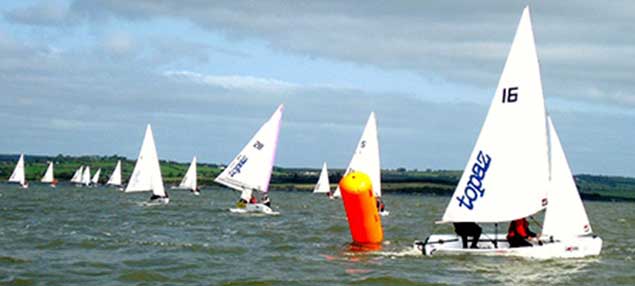 The Topaz Irish Nationals at Foynes reflected the award-winning club’s success as a championship venue. Photo FYC
The Topaz Irish Nationals at Foynes reflected the award-winning club’s success as a championship venue. Photo FYC
In Irish Sailing, The West's Awake
There is really no reasonable comparison between Ireland’s eastern and western seaboards writes W M Nixon. The east coast is quite densely populated, and while it has some areas of impressive scenery, in general it lacks the majestic inlets and islands which make sailing the Atlantic seaboard such a joy. That said, there’s no getting away from the fact that, taken overall, the east coast leads in economic activity, and at the very least there’s no doubting it has much less rain.
But when the rain in the west clears to reveal the coastline in all its glory, the extra precipitation seems a small price to pay for such visual natural abundance. And then too, while there are fewer people, they’re all so much larger than life, and bursting with innovative and entertaining ideas, that you’re inclined to think one western person is worth a dozen easterners.
However, those of us living and doing most of our sailing on the humdrum old east coast have one inescapable and total advantage over those in the west. When our east coast life gets too stressed and samey, we can escape for a while to the big country, fresh air and crazy attitudes of the west.
If you live in the west, you simply can’t genuinely experience this moment of release. But on the east coast, if life gets tedious, all that is necessary is head west for a day or two. The moment you cross the River Shannon, the spirits lift, and as you crest the watershed between the Shannon and Galway Bay, the big generous country of the west is rising on the horizon, and all is much better with the world.
In the west, too, they operate on a different time scale. And they do it in a different time zone. Until the railways of the 19th Century made some national co-ordination of time essential, local time meant that the recognised noon was later the further west you moved. As is only natural, Galway was twenty minutes later than Dublin. It was only with the exigencies of the Great War in 1916 that an Official Act was passed making uniform time-keeping a legal requirement. Oddly enough, no-one seems to have discussed what effect this draconian measure might have had in provoking the outbreak of the Easter Rising in 1916. Be that as it may, all we know for now is that in Galway, they still operate on a local time zone which is at least twenty minutes later than everyone else’s time, and is probably nearer half an hour.
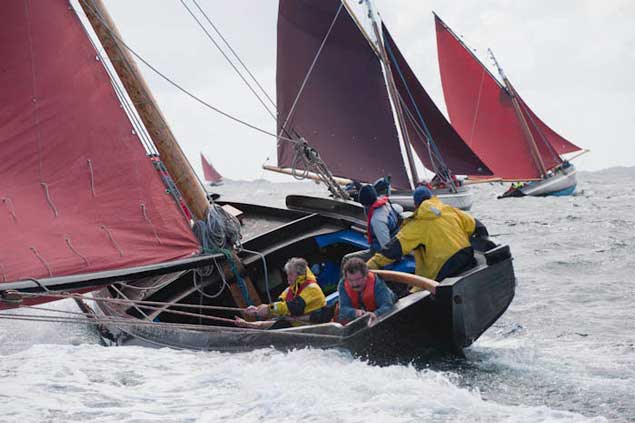 Galway hookers racing hard off the Connemara coast. This is the popular image of sailing in the west, but while vivid and true, the complete story of western sailing is much broader. Photo Paul Harris
Galway hookers racing hard off the Connemara coast. This is the popular image of sailing in the west, but while vivid and true, the complete story of western sailing is much broader. Photo Paul Harris
This became apparent last week when I wheeled into the car park at Galway Bay Sailing Club to give a performance of the current illustrated warblefest, which is about Ireland’s unique relationship with gaff rig and how it has emerged that Irish sailors led the switchover to Bermudan. The details of that will have to wait for another blog, but on this particular night, the immediate concern – with less than a quarter of an hour to go to the advertised start time – was that there just one other car in the car park, and that was Vice Commodore John Murphy, who was there a minute earlier to open the place up for the night.
“Oh Jaysus, Nixon” thought I, “you’ve bombed tonight, there’s not going to be a soul here.” But there wasn’t a moment to brood on the prospect of a showbiz flop, for I was with Pierce Purcell the mover and shaker of the west, and he wanted to show me the almost-finished refurb job they’ve been doing on the ground floor setup in the clubhouse, where they’ve managed to greatly enlarge the floor-space and rationalise its use for a state-of-the art changing room and multiple-use room and boat and equipment store setup.
You know the feeling you get when you’re looking at a job which is going very well indeed. It’s heartening. The re-furb in GBSC is precisely that. It’s being overseen by members Pat and Emer Irwin - he’s the Project Manager and she’s the Architect – and is being done with exemplary efficiency, on time and within a budget of only €160,000, which is the best value in building work I’ve ever seen anywhere.
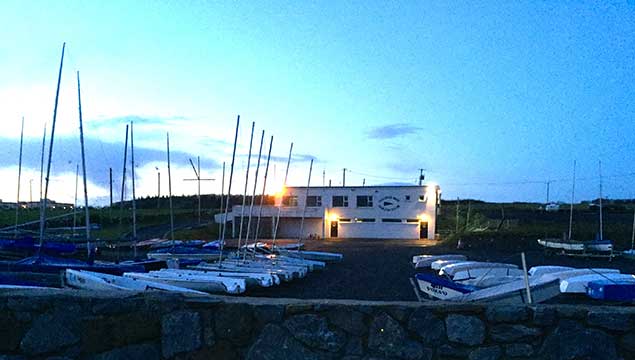 Galway Bay SC is nearing the completion of a clever refurbishment project which is within time, within budget, and excellent value. Photo Pierce Purcell
Galway Bay SC is nearing the completion of a clever refurbishment project which is within time, within budget, and excellent value. Photo Pierce Purcell
We emerged much encouraged from seeing all this to be further cheered by the fact the club was warming up with its famous big stove in the middle of the bar getting into its stride, and the place filling up with people from near and far. For of course I’d temporarily forgotten that Galway’s in a different time zone and it wouldn’t be until around 8.30pm that we’d have some idea of the real turnout, and how effective it might be for the yellow welly collection. This is an idea imported from Poolbeg Y & BC which provides the most painless way of raising funds for the lifeboats. You just provide one yellow RNLI seaboot and request the audience to see how many €5 notes they can get into it. Usually it concludes with some worthwhile figure inevitably ending in either zero or five, but Galway being Galway, the night concluded with the boot yielded up a sum ending with six euro and eight cents……
The show became something we all had to go through with, just in order to justify being there, so it went ahead and finally got to its meandering conclusion. Then the lights went up to reveal even more people had arrived. Pierce Purcell had certainly done his stuff in the phonecall chivvying department, for despite all your modern means of instant total-cover communication, the personal phone call seems to be more important than ever, and the photo below gives some indication of the coverage he achieved, while also hinting at the conviviality of an evening in which a shared love of boats and sailing and a good club atmosphere completely obliterated any feeling of it still being winter outside.
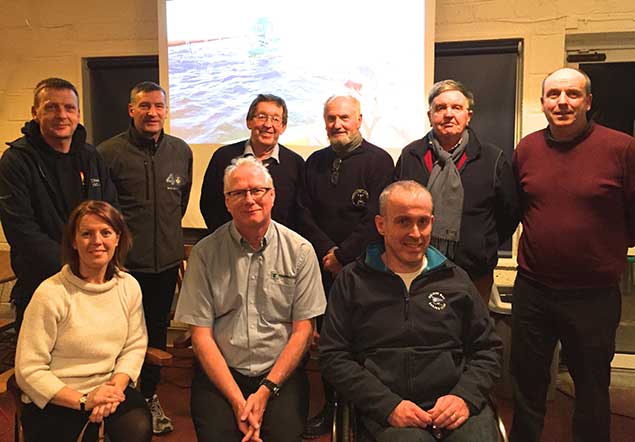 Western gathering. In Galway Bay SC are (back row, left to right) Simon McGibney (Commodore ICRA & ISA Board Member), John Leech (Commodore, Lough Derg YC), Afloat.ie’s W M Nixon, Adrian McConnell (Royal Western YC, Kilrush), Peter Fernie (Rear Commodore Irish Cruising Club) and Richard Glynn (Commodore, Royal Western of Ireland YC). Front row left to right Elaine O’Mahony, (outgoing Hon Sec Foynes YC, 2016 Volvo ISA Training Centre of the Year), Cormac McDonnacha (Chairman, WIORA Week), and Gary Allen, outgoing Commodore GBSC. Photo: Pierce Purcell
Western gathering. In Galway Bay SC are (back row, left to right) Simon McGibney (Commodore ICRA & ISA Board Member), John Leech (Commodore, Lough Derg YC), Afloat.ie’s W M Nixon, Adrian McConnell (Royal Western YC, Kilrush), Peter Fernie (Rear Commodore Irish Cruising Club) and Richard Glynn (Commodore, Royal Western of Ireland YC). Front row left to right Elaine O’Mahony, (outgoing Hon Sec Foynes YC, 2016 Volvo ISA Training Centre of the Year), Cormac McDonnacha (Chairman, WIORA Week), and Gary Allen, outgoing Commodore GBSC. Photo: Pierce Purcell
It was good to talk again with Barry Martin of Galway who made such an impact as bo’sun on the Asgard II many years ago that he found himself being recruited into the same role for both the much larger Britsh sail training schooners Winston Churchill and Malcolm Millar, a job in which he was so successful that he ended his sail training career as a senior officer on the Churchill.
There too were Jim Grealish and Barry Heskin, against whom we used to race inshore and offshore in the days when we each had boats around the 35ft size, boats of very different type yet rating notably similar, so if the Morrisssey-Grealish-Heskin squad appeared on the starting line with Joggernaut, aboard Witchcraft of Howth we knew we were into a boat-for-boat battle in which no quarter would be given, yet everyone would be the best of friends afterwards.
But if there was ample opportunity in GBSC for memories of good times past, equally there was plenty of discussion of the here and now, and it was fascinating to meet up with Dan Mill who runs the busy boatyard in the industrial estate beside Galway Docks. Dan’s story is such that we’ll be developing it into a complete blog in due course, sufficient to say at the moment that his links to Ireland are extraordinarily complex, for although he was born in England, at the age of three his parents together with another family set off to sail to New Zealand from Lymington in the then-bermudan-rigged 43ft Tyrrell ketch Maybird, and Maybird of course is now back in Ireland fully restored as a gaff ketch, and well-known in the ownership of Darryl Hughes.
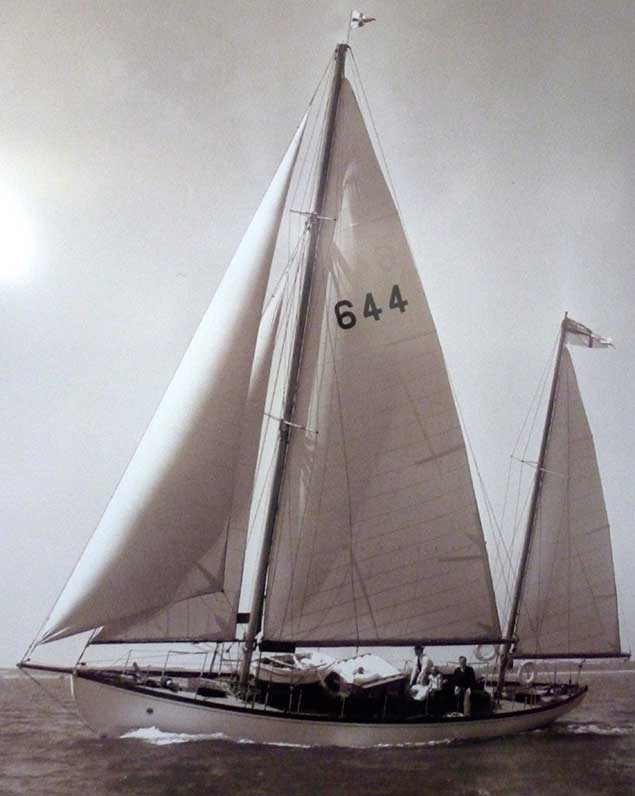 Maybird as a Bermudan ketch. It was under this rig that Dan Mill sailed on her from England to New Zealand while still a child
Maybird as a Bermudan ketch. It was under this rig that Dan Mill sailed on her from England to New Zealand while still a child
As for young Dan, growing up in New Zealand he naturally moved into boat-building in what is probably the best boat-building school in the world, the New Zealand marine industry. But then Mna na hEireann took a hand in his life-path.
It would be difficult to overestimate the influence that the charms of the Women of Ireland have had on the development of a small yet top-level boat-building industry in this country. But there’s something about marine craftsmen and Irish women which gets them together and entices the craftsmen to settle in Ireland despite the fact that, let’s face it, anyone trying to produce such top quality work here is ploughing a lonely furrow a long way from the great centres of the specialist industry, such as the Solent district, parts of the Baltic, certain places in Brittany, and particularly New Zealand.
Yet the women get them, and they get them home to Ireland, and they keep them. Thus we have the likes of Dan Mill in Galway, Steve Morris in Kilrush, and Bill Trafford in the hidden depths of the country near Mitchellstown, all three of them trying to ensure work of the highest quality in a country where “Ah sure, ’twill do” is sometimes the defining motto in woodwork.
Having arrived in Galway, Dan Mill found himself within the orbit of the formidable John Killeen, with whom all ideas are possible, and somehow they found themselves setting out to build a cruising version of an Open 60.
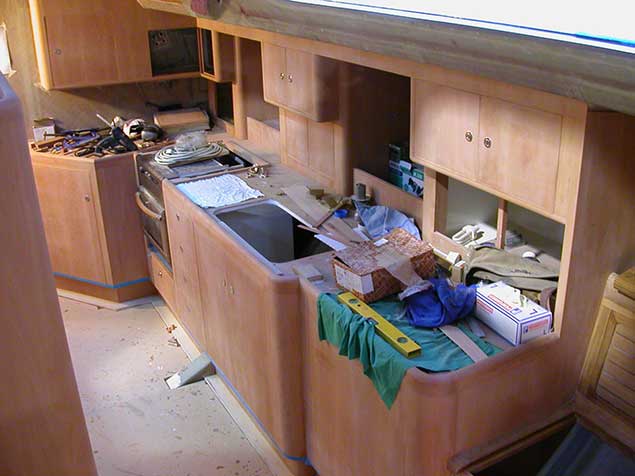 The galley area in Nimmo under construction
The galley area in Nimmo under construction
 Beauty in detail – Dan Mill’s craftsmanship in evidence on a table for Nimmo.
Beauty in detail – Dan Mill’s craftsmanship in evidence on a table for Nimmo.
In the end she became a very one-off 68-footer named Nimmo in honour of the great Scottish harbour engineer Alexander Nimmo, who is one of John’s heroes. When she was eventually finished after four years with Dan being responsible for virtually every bit of skilled work in her complex construction and superb finish, he was exhausted, but his reputation in Galway was well established at a very high level, and he’s now the man to go to with boat maintenance needs and problems. He’s not above undertaking a mid-level job such as putting a new deck and coachroof on an older fibreglass hull, but as for launching another project on the Nimmo scale, that would require some thinking about.
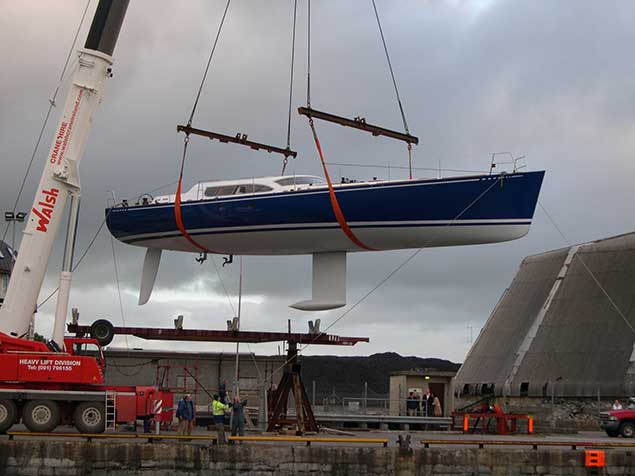 Launching day for Nimmo, built in a very basic shed in Galway
Launching day for Nimmo, built in a very basic shed in Galway Dan Mill this week in the boat yard in Galway
Dan Mill this week in the boat yard in Galway
Nevertheless, talking with the man who built Nimmo was an eloquent reminder that there’s a lot more to sailing in the West than Galway Hookers and other traditional craft. But equally it was a reminder that the traditional skills are still being maintained and indeed nourished out beyond the Pale. So after a leisurely breakfast next morning with Pierce and Susan Purcell in their dream house in Clarinbridge, with a busy red squirrel feasting on the bird table close outside the generous window, there was time to inspect Pierce’s boatshed out the back, one of those green steel sheds which sit so well in the Irish countryside, particularly when – like Pierce – you have your 26-footer comfortably winterised in it, and a fine well-equipped workbench right to hand.
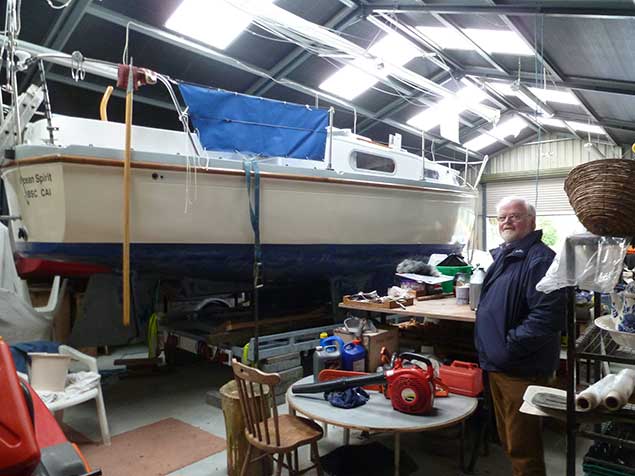 What price a facility like this at your house on the East Coast? Pierce Purcell in “the little shed out the back” at Clarenbridge Photo W M Nixon
What price a facility like this at your house on the East Coast? Pierce Purcell in “the little shed out the back” at Clarenbridge Photo W M Nixon
It’s the sort of ideal setup very few can manage on the over-crowded East Coast, and I headed south musing on the east-west imbalance, and readying the thinking for something entirely different - the Ilen Boat-Building School in Limerick. This started as the backup service for the restoration of the Conor O’Brien 57ft ketch Ilen by Liam Hegarty at Oldcourt near Baltimore, and recently in the Ilen School they’ve produced deckhouses for Ilen to the highest standard, and are currently finishing the last of the new spars.
But under the inspiration of Gary MacMahon (who personally was responsible for bring Ilen home from the Falklands) and others such as Brother Anthony Keane of Glenstal Abbey, the Ilen School has become a remarkable educational and training resource undertaking a wide variety of projects such as creating replicas of the traditional Shannon Estuary gandelows, and building a class of the very handy CityOne sailing dinghies to a design by the late Theo Rye, a successful project which further revealed the multiple talents of that much-mourned expert in every aspect of naval architecture.
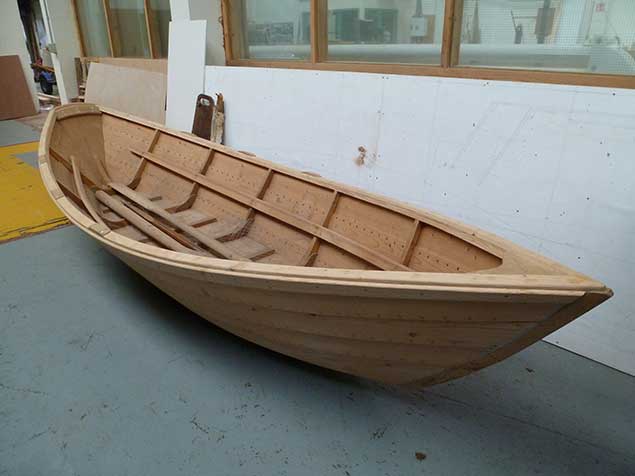 Courses constructing traditional Grand Banks Dories provide popular night classes at the Ilen Boatbuilding School in Limerick. Photo W M Nixon
Courses constructing traditional Grand Banks Dories provide popular night classes at the Ilen Boatbuilding School in Limerick. Photo W M Nixon
Another handy course which the Ilen School offers is through building traditional Grand Banks dories, simple yet effective boats which must have seemed very small indeed as you were left behind in the Grand Banks fog by the Bluenose fishing schooners to get on with the day’s business of ling-lining for cod. By the time the schooner found you again towards evening, your little dory would be dangerously laden with a great catch of wet and scaly silvery wealth.
In fact, the Ilen School is a whole host of experiences, for there in the main work-space were the mighty new spars for Ilen together with the distinctly aged original gaff which goes all the way back to Tom Moynihan and his shipwrights in Baltimore 91 years ago. And in another workspace, the Ilen team are building two very able little dinghies to the Valentine type from dimensions supplied by Hal Sisk, and they will in time be Ilen’s boats. But before you get to these sensibly–shaped little dinghies, you’ve to take on board the Hildasay, the Ilen school’s latest acquisition.
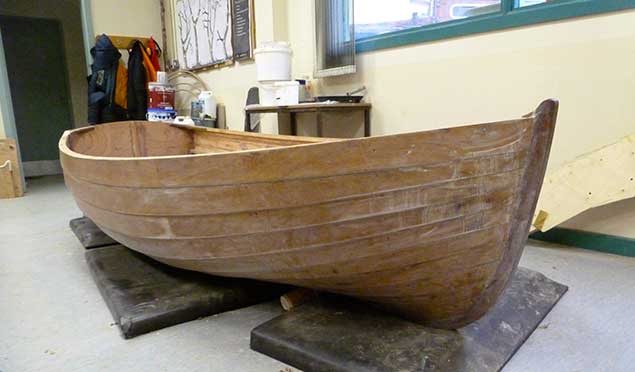 The Valentine dinghy, from plans provided by Hal Sisk, has been built at the school to be a ship’s boat for Ilen. Photo W M Nixon
The Valentine dinghy, from plans provided by Hal Sisk, has been built at the school to be a ship’s boat for Ilen. Photo W M Nixon
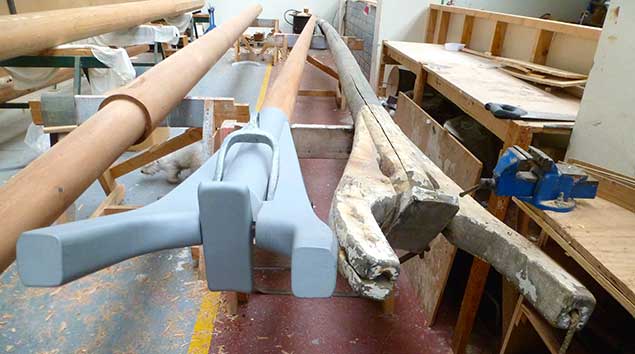 Ilen’s new main gaff boom (left) and the original (right), which was shaped in Baltimore in 1926. Photo W M Nixon
Ilen’s new main gaff boom (left) and the original (right), which was shaped in Baltimore in 1926. Photo W M Nixon
 The mighty mainmast for Ilen, with topmast temporarily in place in Limerick, is ready for dismantling and transport to Baltimore. Photo W M Nixon
The mighty mainmast for Ilen, with topmast temporarily in place in Limerick, is ready for dismantling and transport to Baltimore. Photo W M Nixon
We all know that Limerick is a Viking city, in fact there are those who would argue that it still is, and in its rawest state too. But nevertheless it takes a while to get your head round how a boat like Hildasay, of the very purest Viking descent, should have ended up in a big shed in a trading estate in Limerick.
Hildasay was built in Shetland as a sailing development of the traditional clinker-built sixareen (six oars) in 1951, and is such a sweet little 26-footer that your heart falls for her, even if your head tells you that the slim Viking stern mean there’s very little space just where you most need it most, while the classic clinker construction poses its own special maintenance problems in a vessel which is a semi-keelboat.
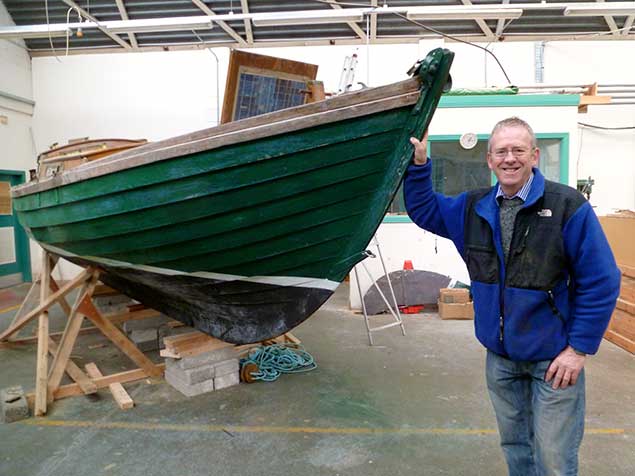 Jack Hawks with the Shetland sailing sixareen Hildasay, whuch he has donated to the Ilen Boatbuilding School. Photo: W M Nixon
Jack Hawks with the Shetland sailing sixareen Hildasay, whuch he has donated to the Ilen Boatbuilding School. Photo: W M Nixon
She has been in and around the Shannon Estuary for abut 15 years, but owner Jack Hawks was recently seriously ill, and though he has fully recovered he felt the demands of Hildasay were getting a little too much for him, and wondered if the Ilen Boat Building School would be interested in her as a gift.
She’s an ideal gift, as she’s of a size to be very manageable, she provides special maintenance problems which, while not enormous, are very educational as part of the school’s courses, and each summer when she’s in commission she could be based either on Lough Derg, or somewhere down the Estuary.
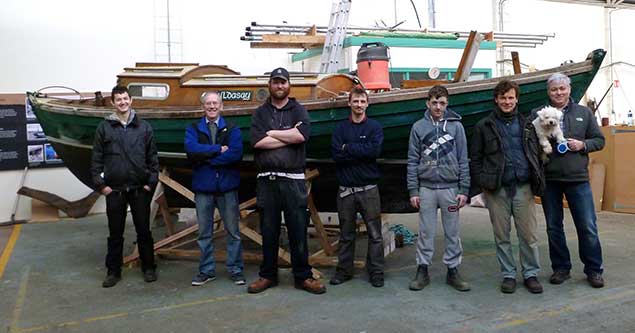 The “day team” at the Ilen School with their new acquisition Hildasay include Luki O’Brien, Jack Hawks, Elan Bromley, Owen Lacey, Sid Dorchenas, Matt Diss, Gary MacMahon and Luna MacMahon. Photo W M Nixon
The “day team” at the Ilen School with their new acquisition Hildasay include Luki O’Brien, Jack Hawks, Elan Bromley, Owen Lacey, Sid Dorchenas, Matt Diss, Gary MacMahon and Luna MacMahon. Photo W M Nixon
The problem in Limerick is that though the Shannon is very much in the midst of it, access to it in the heart of town is limited, and in any case below the weir the big tides are a problem. But up on Lough Derg or further down the Estuary, there are all sorts of opportunities to get conveniently afloat, and having the use of an interesting sailing boat which is bigger than a CityOne or a gandelow is a natural add-on to the Ilen School’s activities, providing a broadening of the mind for some young would-be boatbuilders who may have spent too much time solely at the workbench without seeing what the resulting use of the end product is all about. And who knows, but they might even manage a race with the lovely gaff cutter Sally O’Keeffe built by Steve Morris of Kilrush with the community team from nearby Querrin as a replica of the traditional Shannon Estuary trading hooker.
Having seen the possibilities of mind-broadening in Limerick, the final part of this western tour took in a project which is mind-blowing. Admittedly the good people of the townland of Skenakilla would never for a minute think of themselves as being in the west, but for the rest of us this hidden spot beyond Mitchellstown in North Cork seems to be in the middle of nowhere. But then when you’ve found it, and spent a bit of time with the ebullient Bill Trafford in his remarkable Alchemy Marine boat workshop in Skenakilla, you feel you’re at the hub of the universe.
Bill is another case of Mna na hEireann reeling them in – a classic yachtbuilder and particularly an enthusiast for the International 6 Metre Class, he met an Irish girl and that was that. He made a living plying his highly specialized trade the length and breadth of our island working from a van, and then discovered his own niche in doing interesting, indeed extraordinary things, with old fibreglass boats.
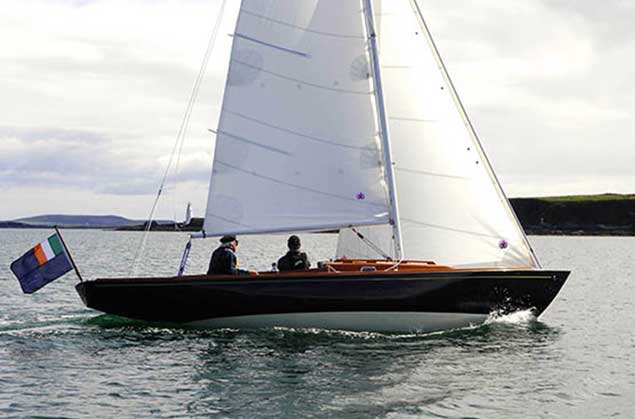 Bill Trafford’s transformation of an Elizabethan 23 won international awards last year.
Bill Trafford’s transformation of an Elizabethan 23 won international awards last year.
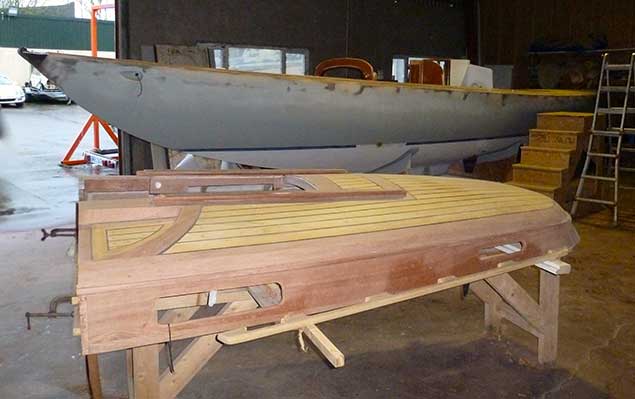 Bill Trafford’s current project at Alchemy Marine is the transformation of an Etchells 22 into a weekend cruiser by raising the freeboard, and providing a beautifully-made coachroof (foreground) Photo: W M Nixon
Bill Trafford’s current project at Alchemy Marine is the transformation of an Etchells 22 into a weekend cruiser by raising the freeboard, and providing a beautifully-made coachroof (foreground) Photo: W M Nixon
 Bill Trafford – he is as enthusiastic about the full potential of glassfibre construction as he is about using classic yacht joinery work. Photo W M Nixon
Bill Trafford – he is as enthusiastic about the full potential of glassfibre construction as he is about using classic yacht joinery work. Photo W M Nixon
He’s unusual in that he’s as enthusiastic about the wide potential of glassfibre construction as he is profoundly satisfied by working in wood to the highest classic yacht standards. While his special abilities were well known to a select few, he came to international notice last year when one of his masterpieces, the complete re-working of a seemingly tired little Elizabthan 23 into an elegant 26ft sloop with a classic New England style, was awarded a top prize in the Classic Boat annual competition.
His current project for a Cork owner is even more intriguing, the transformation of an ordinary and no longer young Etchells 22 into a 34ft LOA day cruiser of unique appearance. He has raised the topsides using glassfibre moulding to give her a completely fresh sheerline, he has transformed the stern by giving it a new-look counter with a curving transom which gives more than a nod in the direction of the unique sterns of the Friendship sloops of Maine, and he has built the most beautiful coachroof in the best Knud Reimers style to provide a boat which comes with a heady combination of Down East and Scandinavia to her.
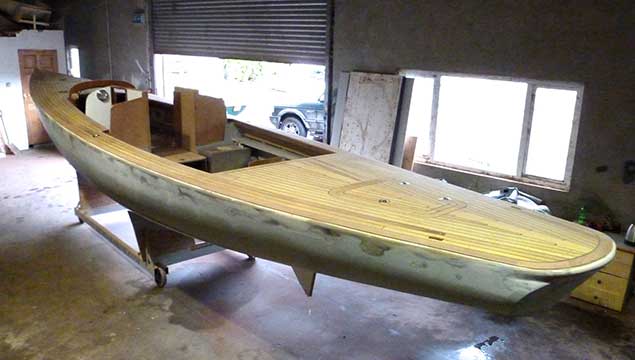 The lengthened stern has seen the rudder being moved aft by half a metre to provide a much roomier cockpit. Photo: W M Nixon
The lengthened stern has seen the rudder being moved aft by half a metre to provide a much roomier cockpit. Photo: W M Nixon
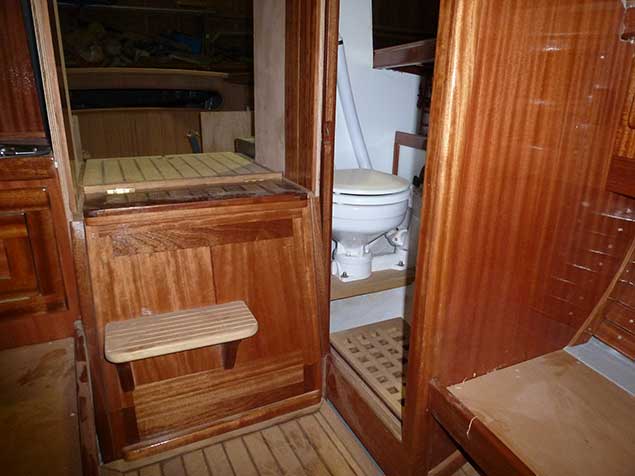 While compact, the accommodation provides for weekend cruising, but it’s expected to be comfortable day sailing which will be the best use of the “new” boat. Photo: W M Nixon
While compact, the accommodation provides for weekend cruising, but it’s expected to be comfortable day sailing which will be the best use of the “new” boat. Photo: W M Nixon
The stern is lengthened such that the LOA is now 34ft instead of the original 30.5ft, and the possibilities this has provided for a large cockpit to match the very pleasant accommodation (including a proper toilet compartment and a Beta diesel auxiliary) have been met by moving the entire rudder half a metre aft.
With his experience of tweaking boats this way and that, Bill reckons the sailing balance will if anything be improved by this re-location of the rudder. Personally, in the standard Etchells I’d always thought it too far forward anyway, so I could live with this change, yet found it entertaining to note that while he talked of moving the rudder aft by half a metre, when I asked him how he calculated the perfect-looking camber in the new deck, he said his rule of thumb is one inch for every four feet of beam. This is as near as dammit one in fifty, but his mixture of measurement systems makes him just like the rest of us who are mere bodgers, for when we’re measuring something we just use the side of the steel rule which comes up first, be it metric or imperial…….
 Under the new foredeck – Bill’s rule of thumb is a deck camber of one in 48. Photo: W M Nixon
Under the new foredeck – Bill’s rule of thumb is a deck camber of one in 48. Photo: W M Nixon
This is very much a bespoke project, so Bill has been able to introduce all sorts of quirky little features, a very attractive one being the ports for the navigation lights, which are set well into the hull either side of the stemhead, and look for all the world like the eyes put in Mediterranean boats to ward off evil spirits. In fact, they give such an appearance of good cheer to this new-old boat that when you see her from ahead, she looks for all the world as though she is smiling so much that she’s about to burst out laughing.
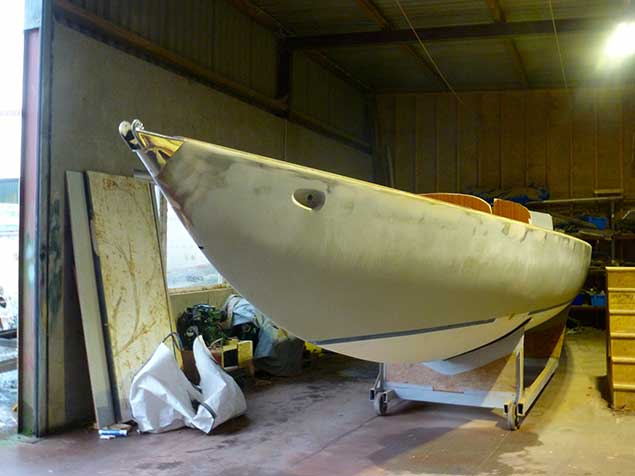 The Watchful One…….it was a Bill Trafford’s idea to build special ports for the navigation lights. Photo W M Nixon
The Watchful One…….it was a Bill Trafford’s idea to build special ports for the navigation lights. Photo W M Nixon
There’s still quite a bit to do before she’s ready for the water, but Bill is now in such a rhythm of working on his own that he can put in long productive hours without really noticing it, so we hope to get back to Skenakilla sooner rather than later. As for those around him, one unexpected advantage of being near Mitchellstown is you’re right in the heart of the dairy engineering industry, where the use and working of stainless steel is second nature. In fact, down there they sometimes use stainless steel which is of a superior grade to the 316 which is usually good enough for the rest of us.
Truth to tell, I didn’t know there were types of stainless steel superior to 316, but you learn many things down in Skenakilla, and it was encouraging to hear that the best workers in the stainless steel fabricating shops are happy to lend their skills in their spare time to bring Bill’s self-made stainless steel fittings up to professional standards of finish.
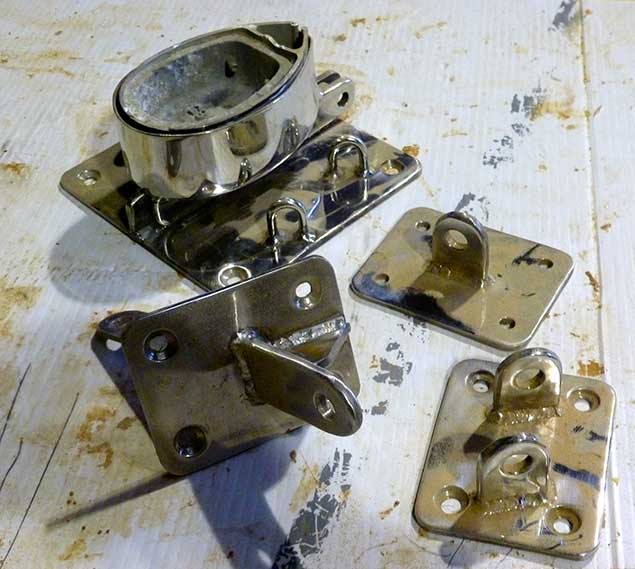 Thanks to the local presence of high-grade stainless steel engineering for the dairy industry, it has been possible to make these fittings in Skenakilla. Photo: W M Nixon
Thanks to the local presence of high-grade stainless steel engineering for the dairy industry, it has been possible to make these fittings in Skenakilla. Photo: W M Nixon
 A work of art in its own right, the new coachroof will be fitted any day now. Photo: W M Nixon
A work of art in its own right, the new coachroof will be fitted any day now. Photo: W M Nixon
All being well, the new boat will be a star at the 25th Anniversary Glandore Classics Regatta from July 23rd to 29th, in fact Bill rather hopes the owner might consider taking her to the Classics Regatta celebrating the Bicentenary of Dun Laoghaire Harbour from July 6th to 9th as part of Volvo Dun Laoghaire Regatta.
The good news here is that Cathy MacAleavey, chair of the Dun Laoghaire Classics organising committee, and Sally Wyles, who heads up the Glandore organisation, got together last weekend to see about selling their two events as a sort of package, as the clear fortnight between them makes participation in both a very realistic proposition.
Certainly the Dun Laoghaire Classics is beginning to look impressive, particularly if you go by the measuring method of counting the number of famous designers involved. The recent interest shown by Rob Mason of Milford Haven to come over with his newly-restored 36ft Alexander Richardson-designed 36ft Myfanwy brings a once-famous Liverpool designer back into the limelight. It’s where he deserves to be, for Richardson designed John Jameson’s all-conquering Irex in 1884.
 Rob Mason with his restored 1897 Alexander Richardson 36-footer Myfanwy off Milford Haven. He has indicated interest in participation in the Bicentenary Regatta in Dun Laoghaire in July
Rob Mason with his restored 1897 Alexander Richardson 36-footer Myfanwy off Milford Haven. He has indicated interest in participation in the Bicentenary Regatta in Dun Laoghaire in July
In Dublin Bay, Myfanwy would see this Richardson creation shaping up to designs by G L Watson, Alfred Mylne, William Fife, John Kearney, O’Brien Kennedy, Arthur Robb and others, and that’s the list already with the net only newly cast.
As for what Glandore can offer, there’s at least one unique proposition. A special race will be sailed to honour the memory of Theo Rye, the fleet including the CityOnes from Limerick and a host of other boats, new and old. On each and every one of them, Theo would have had something new and of real interest to say, for that’s the kind of devoted student of naval architecture he was throughout his far-too-short life. He is much missed.
 Much missed. The late Theo Rye aboard the 1887 Fife cutter Ayrshire Lass, which was restored by Michael Kennedy at Dunmore East. Theo Rye will be commemorated in a special event at the 25th Anniversary Glandore Classics Regatta from July 23rd to 29th. Photo: Darryl Hughes
Much missed. The late Theo Rye aboard the 1887 Fife cutter Ayrshire Lass, which was restored by Michael Kennedy at Dunmore East. Theo Rye will be commemorated in a special event at the 25th Anniversary Glandore Classics Regatta from July 23rd to 29th. Photo: Darryl Hughes
Protections Called For Shannon Dolphins In North Kerry
#MarineWildlife - Conservationists want Tralee Bay and Brandon Bay in North Kerry to be declared a protected marine wildlife zone for bottlenose dolphins.
The call comes in the wake of new research by the Irish Whale Dolphin Group (IWDG) in tandem with the Shannon Dolphin and Wildlife Foundation, which has identified the vast majority of bottlenose dolphins in North Kerry as members of the Shannon Estuary group that has enjoyed Marine Protected Area status since 2000.
“We knew dolphins had been regularly observed in Brandon Bay,” said the IWDG’s Dr Simon Berrow of the new research, “but did not know which population they belonged to and had no idea they were as abundant and frequent as this study has shown.”
Stephanie Levesque, senior author of the study, added that the research identified “very high numbers of Shannon dolphins present during the summer months in Brandon and Tralee Bays.
“If further surveys were to be carried out at various times of the year, including collecting behavioural data, it could help us to better understand how they are using these habitats.”
Elsewhere on the West Coast, Galway Bay FM reports on efforts in Connemara to form local groups in Oughterard and Letterfrack which are designated for the protection of pearl mussels.
More than €7.6bn in Trade Handled by Shannon Foynes Port Company
#TradeReport - More than €7 billion in trade every year was handled by Shannon Foynes Port Company, according to a report commissioned by the State company that runs mid-western harbour, writes The Irish Times.
Research by W2 Consulting, based on 2014 figures from the port itself and 31 companies using it, shows that it is worth €1.9 billion to the wider economy and handles €7.6 billion in trade annually.
It also shows that Shannon Foynes Port Company and its customers plan to spend €277 million between them over the five years to 2019, which will support 3,372 jobs in the region.
The port company intends to spend €130 million on an expansion plan, dubbed Vision 2041 , that will exploit advantages such as its deep water and sheltered harbours to develop an international trade hub there.
For much more including video featuring Chief Executive, Pat Keating, click here.
Topper Topaz National Title Won By Foynes Yacht Club Sailor
The Topper Topaz National Championships took place at Foynes Yacht Club on the Shannon Estuary last Saturday, 13th August.
ISA National Race Officer David Vinnell of Galway Bay Sailing Club alongside local Race Officer Raymond McGibney of the host club were extremely effective in getting racing off on schedule and getting in the full race card of five races in westerly 8-16 knots of breeze.
Racing took place in an area east of Foynes Island and out of the main stream of the River Shannon. After a clean start in race one the fleet remained tight for all of the race until the final beat where Dingle sailors gained a small lead with the rest of the pack hot on their heels.
From the gun in race two almost all of the fleet headed to the right side of the course where there seemed to be more breeze. Just one sailor, Senan Tubridy from Royal Western Yacht Club, was a solitary looking figure on the left side, but correctly judged the sweep of the tide would carry him towards the mark and, by the windward mark had completely cleaned the fleet, holding onto his lead all the way to the finish.
The breeze picked up for race three to over 15 knots and the double handed boats (Uno Plus) started to move up the fleet in the stronger conditions with Adam Byrne & Ciarán Fitzgerald leading the way. While competitors can enter the Topaz Nationals as Uno (one person) or Uno Plus (two people) the Topaz Class Association rules score the event as one fleet, no handicap system is applied. Race four, in similar conditions, was won by an Uno sailor, Dylan Reidy but second and third place went to Uno Plus sailors Adam Byrne/Ciarán Fitzgerald and Diarmuid Desmond/Cillian Fogarty. With the final race approaching the result was still wide open with three boats in the running for the national title and the winners in the age categories still undecided. The lead changed many times throughout the race with the final result two boats were tied on points but on countback Dylan Reidy from the host club was deemed the overall winner ahead of Adam Byrne & Ciarán Fitzgerald from Dingle Sailing Club.
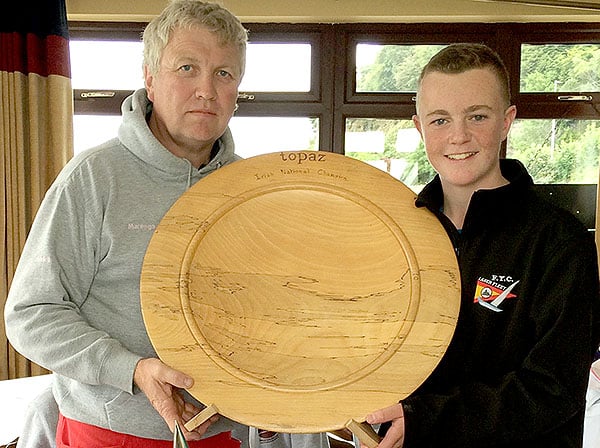 2016 Topaz National Champion Dylan Reidy is presented with his trophy by flag officer Patrick Finucane (left)
2016 Topaz National Champion Dylan Reidy is presented with his trophy by flag officer Patrick Finucane (left)
Racing finished well on schedule and such was the efficiency of the race team the beachmaster was caught completely off guard and asleep on his cruiser as the fleet was returning to shore after racing! Quick wakeup call required!
A notable mention must be made for Dingle sailor Ellie Cunnane, who sailed a superb event, winning three of the five races but following a technical protest was discounted from the event. A gutting decision for the fourteen year old who showed incredible strength of character and great sportsmanship respecting the decision of the protest committee and congratulating the new National Champion, Dylan Reidy.
 The Topper Topaz National Championship sailors at Foynes Yacht Club
The Topper Topaz National Championship sailors at Foynes Yacht Club
Overall Winners
ISA Gold:
Dylan Reidy (Foynes Yacht Club), who also won Topper Topaz Mainsail
ISA Silver:
Adam Byrne / Ciarán Fitzgerald (Dingle Sailing Club), also winning Topper Topaz Toe Straps
ISA Bronze:
Diarmuid Desmond / Cillian Fogarty (Dingle Sailing Club), also winning Topper Topaz Carbon Tiller Extension
Age Category Winners
Under 18 Years: Ella Fay (Dungarvan Harbour Sailing Club)
Under 16 Years: Clara Shanahan / Tadgh Shanahan (Foynes Yacht Club)
Under 14 Years: Oisín Finucane (Foynes Yacht Club)
Under 12 Years: Ross O’Shea (Foynes Yacht Club)
Foynes Yacht Club would like to thank the visitors from Dungarvan Harbour Sailing Club, Dingle Sailing Club, Tralee Bay Maritime Centre and the Royal Western Yacht Club of Ireland for making the effort to attend the event. They would also like to thank the members for volunteering their time to run a great event, National Race Officer David Vinnell and Local Race Officer Raymond McGibney and finally the biggest thanks to sponsors Topper International Ltd., Ronstan (IMP Products) and UK McWilliam Sailmakers for their generous prizes.
Drive to Attract Marine Investment to Shannon Estuary Region
A new marketing drive promoting deep water marine investment opportunities along the Shannon Estuary is being undertaken by stakeholders engaged in the development and management of Ireland’s largest and deepest estuary.
The region’s local authorities, namely Clare County Council, Kerry County Council and Limerick City & County Council, have joined with IDA Ireland, Shannon Commercial Properties and Shannon Foynes Port Company in producing a prospective Marketing Brochure package that details ‘Deep Water Marine Investment Opportunities’ at 6 Strategic Development Locations deemed appropriate for marine-related investment.
The package is being distributed to potential investors around the world while a dedicated new website, www.shannonestuary.ie has been launched.
1,220 hectares of land at the 6 sites are zoned for marine-related industry in Regional and Local statutory development plans. The sites include Moneypoint (280Ha), Innismurry/Cahericon (65Ha) in County Clare, Askeaton (98Ha), Foynes Island (40Ha), and Foynes Port and adjoining lands (186Ha) in Limerick and Tarbert - Ballylongford Landbank (550Ha) in County Kerry.
The promotion of investment and development opportunities is the result of the Strategic Integrated Framework Plan (SIFP) for the Shannon Estuary, a land and marine-based plan launched in late 2013 by a multi-agency steering group comprising member organisations from throughout the wider region.
The Shannon Estuary features 500km2 of navigable water running from Kerry Head and Loop Head as far as Limerick City, a distance of 100km. The Estuary is Ireland’s premier deepwater port routinely catering for ships up to 200,000 deadweight tonnage (dwt) with key ports at Limerick and Foynes and direct connectivity to all major international shipping lanes. It is home to a number of large industries and employers, including ESB Moneypoint, Aughinish Alumina, Tarbert Power Station, Shannon International Airport and NORA Fuel Reserve.
“The Shannon Estuary Region is an attractive investment location for companies in the pharmaceutical, manufacturing and ICT sectors due to the global connectivity offered by Shannon Airport, the quality of lifestyle, and the abundance of world-class third level education facilities and graduates,” said Brian McCarthy, Senior Planner, Planning and Enterprise Development, Clare County Council, lead authority on the SIFP for the Shannon Estuary.
“The presence of large-scale marine-based facilities, 1,220 Hectares of zoned land, and the existing sheltered deep water resource presents considerable new investment potential along the Shannon Estuary,” he added.
Mr. McCarthy continued, “This multi-agency approach is aimed at sustainably accommodating future development, economic growth and employment within the Shannon Estuary. By working to attract new investment opportunities we are cognisant of the need to achieve a careful balance between promoting development, and the protection and conservation of this natural resource.”
Niall O’Callaghan, Business and Relationship Manager, IDA Ireland said, “As Ireland’s Foreign Direct Investment Agency, we at IDA Ireland very much welcome the completion of the SIFP marketing material and look forward to distributing it with our network of Overseas Teams. The Shannon Estuary is a key pillar in the potential attractiveness of the Mid-West to new forms of foreign direct investment and, aligned with IDA Ireland’s Regional Strategy through the Action Plan for Jobs I very much welcome the delivery of this project.”
“The culmination of many months work with our stakeholders within the Mid-West Region, the full potential of the SIFP can only be achieved with a coordinated delivery of infrastructure to support the 6 Strategic Sites that have been identified,” said Mr. O’Callaghan. “With this outcome, we can remain optimistic about the future potential investment in the Estuary, both land and marine based.”
The existing facilities on the Estuary are serviced by the largest vessels entering Irish waters while all commercial marine activities on the Shannon Estuary are managed and controlled by Shannon Foynes Port Company.
Pat Keating, CEO, Shannon Foynes Port Company commented “As Ireland’s largest bulk-port company and the port authority for the Shannon Estuary, Shannon Foynes Port Company (SFPC) views the implementation of the SIFP as vital to realising the commercial maritime opportunities afforded by the unequalled naturally occurring deep waters of the Shannon Estuary.”
“The zoning of over 1,200 hectares across the six Strategic Developments Locations identified in the Strategic Integrated Framework Plan (SIFP) for the Shannon Estuary is extremely important in that it identifies, once and for all, the necessary land to facilitate the sustainable maritime development of this national strategic asset. The SIFP is also closely aligned with our own 30 year masterplan Vision 2041, under which €38m was invested in the SFPC port estate in 2015 alone.
“It is only with the ongoing collaboration and cooperation of all the stakeholders that we can fully realise the enormous estuary potential and the implementation of the SIFP is an important step in this regard,” stated Mr. Keating.
Welcoming the collaborative stakeholder approach, Ray O’Driscoll, Managing Director, Shannon Commercial Properties said: “As part of Shannon Group plc which provides global connectivity through Shannon Airport, and through Shannon Commercial Proprieties owns one of Ireland’s largest property portfolios, we are delighted to be part of this initiative which will promote development opportunities in the Shannon Estuary.”
“Shannon Commercial Properties owns significant land banks at Ballylongford and Askeaton, two of the 6 strategic development locations and we are actively engaging with all stakeholders to realise the full potential of these assets,” concluded Mr. O’Driscoll.
Topper Topaz National Championships 2016
This August Foynes Yacht Club will host the 2016 Topper Topaz National Championships. The event will run over two days, Saturday 13th and Sunday 14th August writes Elaine O'Mahoney.
This is the club’s second year hosting the event which last year had 34 entries. This year the club has set itself a target of 50 boats. The event is open to anyone sailing Topaz Uno (one person) or Topaz Plus (two people). We would like to invite the sailing schools to enter a fleet with a special offer to enter five and get the sixth entry free. The aim is to have a fun and exciting event with competitors ranging from seasoned sailors to complete beginners at this level with a number of entrants taking the step from Optimist and Toppers to Topaz’ for the first time.
The selection of date also allows for a nomination to be made to the Irish Sailing Association for the All Ireland Junior Sailing Championships which will be run the the Fastnet Marine OEC in Schull on the 25th & 26th September. The Irish Sailing Association makes the final decision on invitations to the All-Ireland Junior Sailing Championships.
Foynes Yacht Club are delighted for the second consecutive year to have Topper International Ltd. onboard sponsoring the overall prizes (1st Topaz Uno Racing Sail, 2nd Set of Hyde Padded Toe Straps, 3rd Carbon Tiller Extension) and also to have Ronstan (IMP Products), UK McWilliam Sailmakers and Hyde Sails generously sponsoring prizes in the different categories including under 18, under 16, under 14 and under 12, single and double handed.
Foynes Yacht Club has camping facilities on the grounds with 24 hr access to the clubhouse for showers and use of the kitchen etc.
The Notice of Race and Entry Form are available to download from the club website. If you require further information on this event contact Elaine or Simon on 087 3354153.
Class two yacht Ibaraki skippered by John Collins from Galway Bay Sailing Club has been declared overall winner of the 2016 WIORA Championships after a six race series at Kilrush Marina on the Shannon Estuary. Download results below.
Collins continued his overall lead into the final two races on Sunday, emerging a clear winner with a four point margin. The modified GK34 beat Liam Burke's Corby 25 Tribal on 13.5 points with Ray McGibney's Dehler 34 Disaray from Foynes Yacht Club third on 15 points.
In class one at the Royal Western Yacht Club of Ireland event, Yannick Lemonnier's Galway Flyer, an SJ320, from Galway Bay Sailing Club, beat the First 36.7, 2 IRL1514 Zallaq (Duncan & Emmet Kerin) from the host club in a five–boat fleet.

The WIORA prizegiving at the Haven, Kilrush with John Collins's Ibaraki crew lifting the overall trophy. Photo: WIORA/Facebook
In a five boat class three made up entirely of J24s, Darragh McCormack's Maximus from Foynes Yacht Club was the overall winner. Simon McGibney's Carpe Diem was second ahead of third placed Jibe sailed by Fergus Kelliher of Tralee Bay Sailing Club.
In a white sails fleet of 13 boats, the overall winner was Tom Murray's Kerry Sloop, Kerry Dream, with Pat Keating on Excalibur in second. James McCormack on Alpara finished in third place. The top three were all from Foynes Yacht Club.
30–boats competed in three classes in the 40th anniversary of the event.
Additional reporting by Elaine O'Mahoney, WIORA:
The event took place over four days in heavy winds which even in the ‘lulls’ hardly dropped below 15 knots.
Looking ahead at the forecast the race officers made the decision to have three races on day one as a contingency in case any of the subsequent days were blown out. The IRC racing on day one was windward leeward courses west of Scattery Island where OOD Alan Crosbie and his team did a fantastic job in shifty conditions requiring moving of marks between legs to keep the beats true. Winds of about 25 knots and strong tides were a certainly challenge with some of the bigger boats reefed down and the smaller boats all with jibs but the general consensus of the competitors was hugely enjoyable racing.
It was decided to have the longer coastal race on day two which had the IRC classes beat about six miles west in the estuary towards Carrigaholt. Trusting the weather forecast the OOD handed out the race course to all competitors prior to leaving the Kilrush Marina. As the start time approached the first ‘beat’ was looking more like a ‘fetch’ but as if Alan Crobie flicked a switch just as he sounded the first warning signal the wind backed about 25 degrees to make the first beat a proper one. And for anyone not familiar with sailing in tidal waters, one boat commented afterwards it took them nearly two hours to beat to the windward mark and twenty five minutes to get back. Welcome to sailing in tides! The contingency decision made earlier paid off as Friday saw winds of between 35 and 40 knots blow though. The shelter provided in the recently refurbished, and I must say looking smashing, Kilrush Marina was much appreciated by all the boat owners.
The final day of racing winds brought winds gusting up to 30 knots and wind shifts of 30 degrees to contend with and the race organisers did very well to get in a final two races which brought a discard into play for all competitors.
Across all the classes racing was hugely competitive. In the six race series the most races won by any of the overall winners was three races, which was Yannick Lemonnier’s Galway Flyer in Class One while Emmet & Duncan Kerin’s First 36.7, Zallaq came in 2nd and 3rd place went to Liam Madden’s X332 Dexterity.
In Class Two, the eventual overall champions, John Collins’ GK34, Ibariki had two wins out of six claiming the class ahead of last years’ winner Liam Burke’s Corby 25 Tribal with the Dehler 34 Dis-a-Ray under the new helm of Fionn McGibney finishing 3rd.
In class three, an all J24 affair, there was nothing between the fleet who, no matter what tactics employed or what side of the course taken, seemed to converge together at every single mark! At the end of the first day the top three boats were level on points. With just one win throughout the series it was the consistency of Darragh McCormack’s J, Maximus, which kept them at the top. 2nd and 3rd place, who both had two wins each, finished level on points but on countback Martin McNamara on Carpe Diem took 2nd ahead of Fergus Kelliher on Jibe in 3rd.
In what has been hailed by the White Sails fleet as a huge success, WIORA for the first time brought in a second OOD, Peter Moore from Tralee Bay Sailing Club, to officiate the White Sails racing. The 13 boat fleet stayed further east along the estuary between Scattery Island and Tarbert. While at the pre-race briefing the competitors spoke of White Sails ‘going out to have fun’ nothing could be further from the truth once the first gun was sounded. The courses were Round The Cans and competition was fierce with the series leader changing many times throughout the four day event. In the end the experience of the Foynes Yacht Club boats in sailing in the strong tidal waters came through as first, second and third places all went to the Shannon Estuary based club. Tom Murray’s Kerry Sloop, Kerry Dream, was relishing the heavy weather taking first place overall with Pat Keating on Excalibur, competing in his first West Coast Championships on his Westerly Fulmar, but with a few crafty and well-seasoned sailors on board came in second. James McCormack’s Dufour 35 Alpara, finished in third place. The two White Sails boats that came down from the lake thanked the West of Ireland Offshore Racing Association and the Irish Cruiser Racing Association for their generosity in helping them get lifted and transported down for the event due to the lower River Shannon being closed at Ardnacrusha.
WIORA Commodore, Simon McGibney congratulated Adrian O’Connell and the members of The Royal Western Yacht Club of Ireland and Thomas Whelan, Chairperson of the Organising Committee for hosting what was widely agreed was a fantastic event. He also thanked the OOD’s Alan Crosbie and Peter Moore and their teams for exceptional racing in testing conditions and finally thanked Kilrush Credit Union, Kilrush Marina and all the other sponsors of the event.
Overall Winners:
Class One IRC :
Galway Flyer (Jannick Lemonnier, Galway Bay Sailing Club)
Class One ECHO:
Dexterity (Liam Madden, Foynes Yacht Club)
Class Two IRC:
Ibaraki (John Collins, Galway Bay Sailing Club)
Class Two ECHO:
Ibaraki (John Collins, Galway Bay Sailing Club)
Class Three IRC:
Maximus (Darragh McCormack, Foynes Yacht Club)
Class Three ECHO:
Carpe Diem (Martin McNamara, Foynes Yacht Club)
White Sails:
Kerry Dream (Tom Murray, Foynes Yacht Club)
Full Results can be found below.
Clare Man Found Guilty of Illegal Netting on the Shannon Estuary
At a sitting of Kilrush District Court on 11th April 2016, Judge Patrick Durkan convicted a man of illegal netting for salmon on the Shannon Estuary. Mr John Beehan with an address at Burrane, Kilimer, Co Clare, was fined €500 in addition to costs amounting to €500.
Judge Durkan heard evidence that while carrying out surveillance on an area near Kilimer, Co Clare in June 2015, fishery officers observed Mr Beehan to be in control of a fishing net which had two salmon caught in it. The officers gave evidence and were cross-examined. Mr Beehan’s defence was that he had been curious to see what was going on in the area as he had seen an unfamiliar car and he denied that the fishing net was his.
In summarising his judgement on the case, Judge Durkan said that he was satisfied that there was a case to answer. He added that the motor car was very important in the defence of “taking a look” and the reason for this could only be that the car had a boot.
Ms Amanda Mooney, Director at Inland Fisheries Ireland, Limerick, commented: “Netting for salmon in the Shannon Estuary is prohibited. Such illegal fishing is an environmental crime and is a contributing factor to the decline of Ireland’s vulnerable salmon stocks.”
Inland Fisheries Ireland (IFI) has a confidential hotline number to enable members of the general public to report incidents - 1890 34 74 24 or 1890 FISH 24. This phone line is designed to encourage the reporting of incidents of illegal fishing, water pollution and invasive species.


























